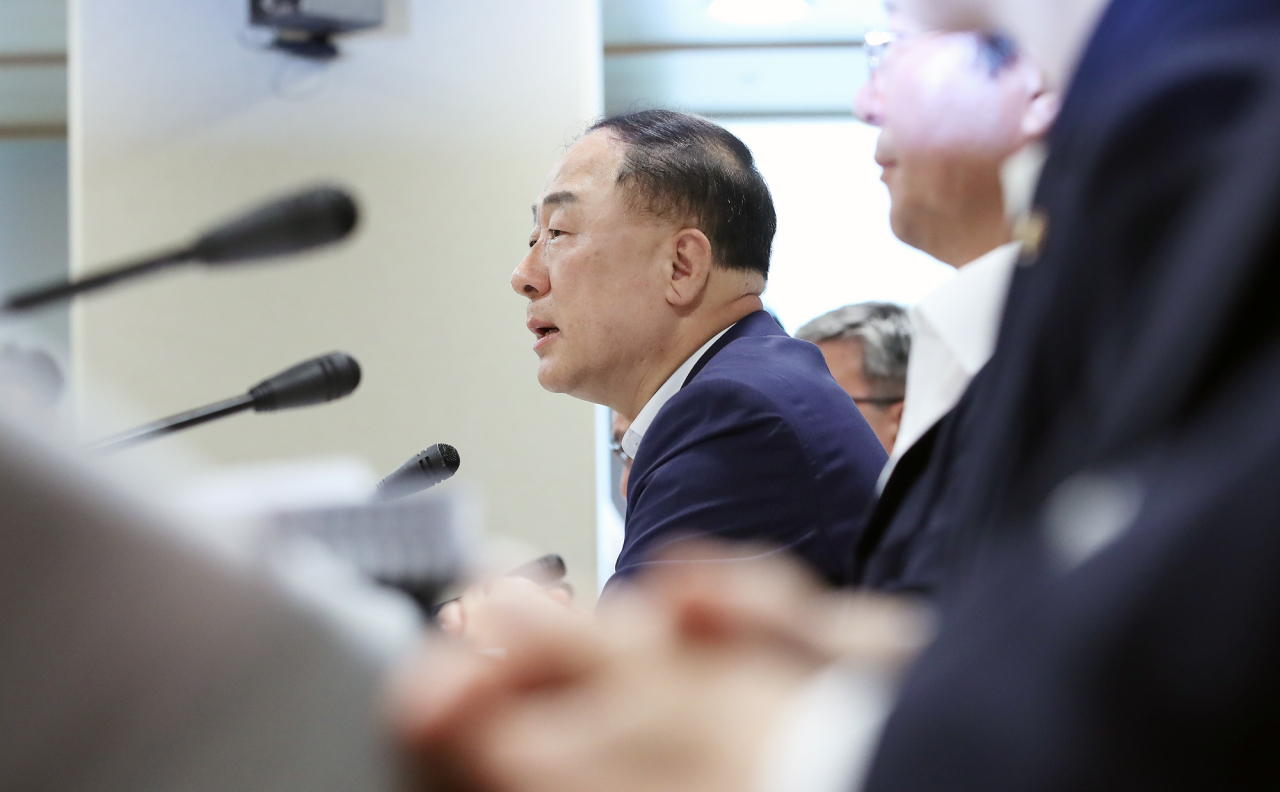South Korea’s government on Wednesday revised the growth rate forecast for this year to 2.4-2.5 percent, down 0.2 percentage point from its earlier estimation, amid sluggish exports and investments.
It also added pressure upon the National Assembly to swiftly approve a long-pending supplementary bill of 6.7 trillion won ($5.7 billion) dedicated to economic revitalization.
 |
Deputy Prime Minister and Finance Minister Hong Nam-ki speaks in a press briefing, announcing the government’s revised outlook on the nation’s economy for the second half of the year. (Yonhap) |
“The government has devoted all efforts to achieve an economic paradigm shift but uncertainties such as the global economic slowdown and the US-China trade conflict have caused difficulties,” said Deputy Prime Minister and Finance Minister Hong Nam-ki in a press briefing with other economy-related ministers.
“Due to the open, trade-dependent structure, our economy faces an especially high level of downside risks, as well as challenges in exports and investments.”
Japan’s recent actions of tightening regulations on Seoul’s exports were not factored in on the revision of the growth rate, the fiscal policymaker added.
The event, held at the state-run Export-Import Bank of Korea headquarters in Yeouido, was attended by ICT Minister Yoo Young-min, Trade Minister Sung Yun-mo, Labor Minister Lee Jae-kap, Land Minister Kim Hyun-mee, SME Minister Park Young-sun and Financial Services Commission Chairman Choi Jong-ku.
The largely speculated markdown of the country’s yearly growth outlook came in the wake of pessimistic figures, including the prolonged low inflation and the record downtrend of export accounts observed lately.
Asia’s fourth-largest economy saw its exports add up to $44.2 billion in June, down 13.5 percent from the previous month, marking the steepest on-month fall since January 2016, according to the Ministry of Trade, Industry and Energy on Monday.
Data by Statistics Korea showed that the consumer price growth pace remained in the zero percent range for a sixth consecutive month in June.
The government also cut down on its forecast for private consumption growth, setting the on-year growth at 2.4 percent, down 0.3 percentage point from the previous estimate.
Equipment investment is likely to turn to a contraction of 4 percent, dipping from the previously suggested growth of 1 percent.
The key task in improving these sluggish investment and growth situations is to pass the 6.7 trillion won extra budget bill as soon as possible and allocate the amount to top priority sectors to revitalize investments and exports, according to the fiscal policymaker.
“The government shall see to it that 70 percent or more (of the budget amount) is executed within two months, once the budget bill is passed,” Hong said.
Placing priority focus on motivating the private sector, the government listed a series of tax benefits for businesses that display commitment to investments.
For instance, companies investing into productivity improvement projects will be subject to a 1-3 percent increase in tax deduction rate, depending on their respective size.
The government also vowed to sustain the Moon Jae-in administration’s economic slogans of inclusive growth and inclusive growth, in order to respond preemptively to long-term structural changes.
Should the budget execution and economic revitalization plans proceed as planned this year, the growth rate for next year is likely to climb slightly to 2.6 percent, according to the Ministry of Economy and Finance.
“We expect that the semiconductor exports will recover to a certain extent as external challenges alleviate,” said an official.
“Taking effect from the rebound (of the chip business), the current account surplus for next year is expected to reach $63.5 billion, up slightly from this year.”
By Bae Hyun-jung (
tellme@heraldcorp.com)








